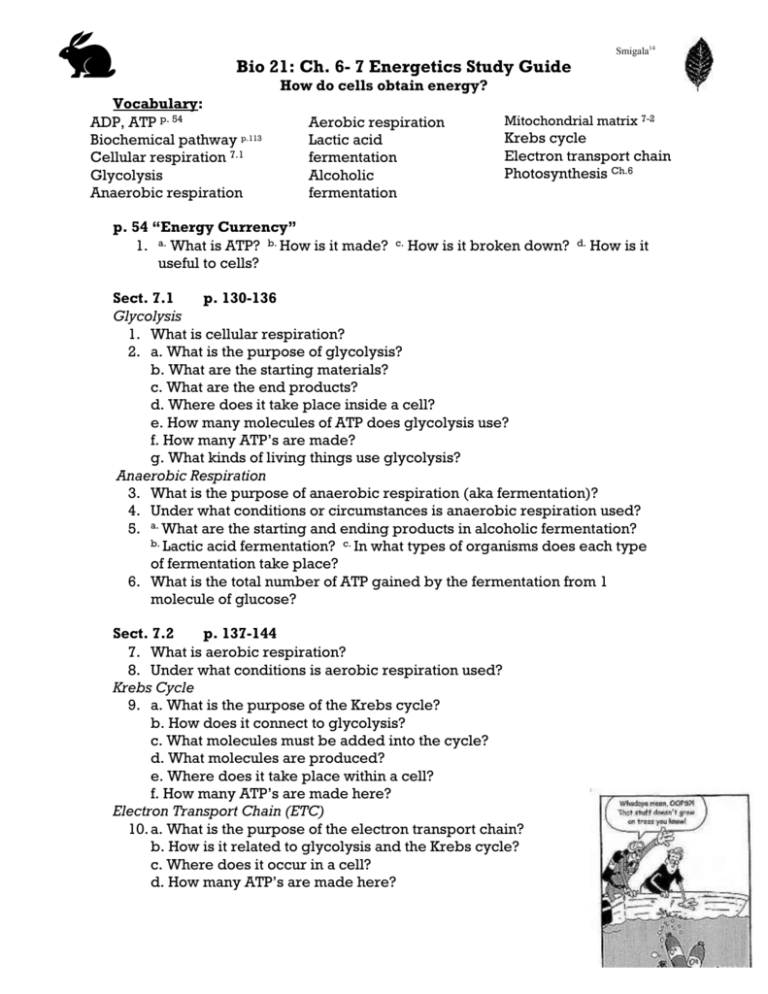Ch. 6 - Fairfield Public Schools
advertisement

Smigala14 Bio 21: Ch. 6- 7 Energetics Study Guide How do cells obtain energy? Vocabulary: ADP, ATP p. 54 Biochemical pathway p.113 Cellular respiration 7.1 Glycolysis Anaerobic respiration Aerobic respiration Lactic acid fermentation Alcoholic fermentation p. 54 “Energy Currency” 1. a. What is ATP? b. How is it made? useful to cells? c. Mitochondrial matrix 7-2 Krebs cycle Electron transport chain Photosynthesis Ch.6 How is it broken down? d. How is it Sect. 7.1 p. 130-136 Glycolysis 1. What is cellular respiration? 2. a. What is the purpose of glycolysis? b. What are the starting materials? c. What are the end products? d. Where does it take place inside a cell? e. How many molecules of ATP does glycolysis use? f. How many ATP’s are made? g. What kinds of living things use glycolysis? Anaerobic Respiration 3. What is the purpose of anaerobic respiration (aka fermentation)? 4. Under what conditions or circumstances is anaerobic respiration used? 5. a. What are the starting and ending products in alcoholic fermentation? b. Lactic acid fermentation? c. In what types of organisms does each type of fermentation take place? 6. What is the total number of ATP gained by the fermentation from 1 molecule of glucose? Sect. 7.2 p. 137-144 7. What is aerobic respiration? 8. Under what conditions is aerobic respiration used? Krebs Cycle 9. a. What is the purpose of the Krebs cycle? b. How does it connect to glycolysis? c. What molecules must be added into the cycle? d. What molecules are produced? e. Where does it take place within a cell? f. How many ATP’s are made here? Electron Transport Chain (ETC) 10. a. What is the purpose of the electron transport chain? b. How is it related to glycolysis and the Krebs cycle? c. Where does it occur in a cell? d. How many ATP’s are made here? Smigala14 Aerobic Respiration Overall 11. What is the chemical equation that summarizes the process of aerobic respiration? 12. What is the total number of ATP’s gained by breaking down 1 molecule of glucose by aerobic respiration? (Include glycolysis in your calculations.) 13. Where is oxygen used in this process? Where does oxygen come from for aerobic respiration? 14. Where do the 2 major waste products, carbon dioxide and water, go after the glucose has been broken down? 15. What kinds of living things use aerobic respiration? Ch. 6 16. What is photosynthesis? 17. Why is the process of photosynthesis important to all living things? Photosynthesis overview: 18. Write the chemical equation for photosynthesis. Make Connections: Aerobic & Anaerobic Respiration and Photosynthesis: 19. Under what circumstances do higher organisms including humans use fermentation? Why don’t we use this process all of the time? Why do many of our cells have the ability to carry out both aerobic and anaerobic respiration? 20. How are photosynthesis and cellular respiration related? 21. Put the following pathways in order in terms of which evolved 1st, 2nd and 3rd: aerobic respiration, anaerobic respiration, photosynthesis. Smigala14 Name: Ch. 6-7 Review: Cellular Respiration The cartoons below illustrate photosynthesis. Use the cartoons to help inspire your own cartoons for the reactants and products for the three different forms of cellular respiration that you have learned about: a. Aerobic respiration b. Alcoholic fermentation c. Lactic acid fermentation








